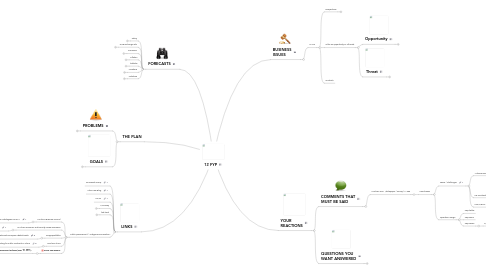
1. FORECASTS
1.1. Salary
1.1.1. Average manufacturing salaries will triple in 5 years
1.1.2. Salaries are going to rise 15-20%
1.1.2.1. Is the party over?
1.1.3. Andy Xie 400% increase over 10 years for unskilled / semi-skilled
1.1.4. Shift in position of Govt. Labour Bureaus, Unions
1.1.4.1. WAS:
1.1.4.1.1. keep salaries low
1.1.4.1.2. suppress "trouble makers"
1.1.4.2. TO BECOME:
1.1.4.2.1. neutral
1.1.4.2.2. even support demands for higher salaries
1.2. RMB exchange rate
1.2.1. Free float would force RMB +10-20%
1.2.1.1. Exported product from China will get more expensive
1.2.1.1.1. benefits extraction
1.2.1.1.2. harms labor intensive
1.2.1.1.3. less exports
1.2.1.2. Imported products will become less expensive in China
1.2.2. 3-5% percent one-time correction coming soon
1.2.3. China Is On The Brink Of A Huge Yuan Revaluation
1.3. Consumer
1.3.1. trends
1.3.1.1. more emphasis
1.3.1.1.1. services
1.3.1.2. salaries get higher
1.3.1.2.1. more money to spend
1.3.1.3. social security works better
1.3.1.3.1. no need to save so much
1.3.1.3.2. more consumption (vs saving)
1.3.2. opportunities for developing incredible and highly profitable consumer businesses will explode
1.3.3. segments
1.3.3.1. extraordinary growth in premium consumer businesses
1.3.3.1.1. JL: maybe even so in in mid tier segment?
1.3.3.2. much larger, more brutal and dynamic mass consumer markets.
1.4. Inflation
1.4.1. prices go up
1.4.1.1. stimulus package heats the economy
1.4.1.2. energy prices go up
1.4.2. increase in household income
1.5. bubbles
1.5.1. real estate
1.5.1.1. housing
1.5.1.2. commercial
1.5.2. internet
1.5.2.1. renren ipo
1.6. Locations
1.6.1. Go central, go west
1.6.2. go t2, t3, t4
1.7. Industries
1.7.1. Transport
1.7.1.1. Rail system investment next 10 years will be less than last 10 years
1.7.1.1.1. CCTV
1.7.2. Energy
1.7.2.1. Shortages (central and west will suffer more)
1.7.2.1.1. Energy
1.7.2.1.2. Diesel
1.7.3. services
1.7.3.1. the government will aggressively promote service consumption
1.7.3.1.1. incentives
2. LINKS
2.1. Brunswick Group
2.2. China Law Blog
2.3. KPMG
2.4. McKinsey
2.4.1. What will happen in China 2011?
2.4.2. Understanding China's Growing Love For Luxury
2.5. fast-track
2.5.1. slides in flickr
2.6. Public procurement / "indigenous innovation"
2.6.1. US-China Business Council
2.6.1.1. Provincial and Local-Level Indigenous Innovation Catalogues 02-2011
2.6.2. US China economic and security review comission
2.6.2.1. 2010 Report to Congress
2.6.3. Kauppapolitiikka
2.6.3.1. Kiinan julkiset hankinnat Euroopan näkökulmasta
2.6.4. EuCham China
2.6.4.1. European Business Experiences Competing for Public Contracts in China
2.6.5. STOP THE PRESS:
2.6.5.1. USCBC Special Report: China Delinks Innovation and Procurement Policies (May 10, 2011):
3. THE PLAN
3.1. PROBLEMS
3.1.1. Industrial
3.1.1.1. Resource constraints: energy and raw materials.
3.1.1.2. Weakness in capacity for domestic innovation.
3.1.1.3. Production structure is not rational: too much heavy industry, not enough service.
3.1.1.4. Agriculture foundation is thin and weak.
3.1.1.5. Obstacles to scientific development continue to exist and are difficult to remove.
3.1.2. Social
3.1.2.1. Mismatch in investment and imbalance in consumption.
3.1.2.2. Income disparity
3.1.2.2.1. Poverty
3.1.2.2.2. distribution of that wealth is unfair and unhealthy.
3.1.2.3. Urban/rural development is not coordinated.
3.1.2.4. Employment system is imbalanced.
3.1.2.5. Social contradictions are progressively more apparent.
3.1.3. Solution
3.1.3.1. Economic development
3.1.3.1.1. Solves all problems
3.1.3.2. Development must be “scientific,” practical (unconstrained by ideology), human centered, and sustainable.
3.2. GOALS
3.2.1. Industries
3.2.1.1. Nine key manufacturing industries
3.2.1.2. Seven strategic industries
3.2.1.2.1. Energy saving and environmental protection (clean energy technology)
3.2.1.2.2. Next generation IT
3.2.1.2.3. Bio-technology (pharma and vaccine manufacturers)
3.2.1.2.4. High end equipment (airplanes, satellites, high speed rail, power plants, manufacturing technology)
3.2.1.2.5. New energy (nuclear, wind, solar)
3.2.1.2.6. New materials (rare earths, nano technology, carbon fiber and related)
3.2.1.2.7. New energy autos and related (electric and hybrid cars, batteries)
3.2.2. Balancing
3.2.2.1. from investment toward consumption
3.2.2.2. from foreign demand to domestic demand
3.2.2.2.1. public
3.2.2.2.2. consumer
3.2.3. Implementation
3.2.3.1. Local government to create plans
3.2.3.2. The ability of the central government to exert it's will on what happend at local level is often exaggerated
3.2.4. Consequences
3.2.4.1. More demand
3.2.4.2. Chinese receiving subsidies
4. BUSINESS ISSUES
4.1. 12 FYP
4.1.1. Perspectives
4.1.1.1. Global economy
4.1.1.1.1. = looks bad
4.1.1.2. Chinese economy
4.1.1.2.1. domestic market
4.1.1.2.2. service market
4.1.1.2.3. consumer market
4.1.1.2.4. overall
4.1.1.3. Industries
4.1.1.3.1. Demand drivers
4.1.1.3.2. Finnish advantage
4.1.1.4. Location
4.1.1.4.1. BJ, SH, SZ vs Others
4.1.1.4.2. East vs. West
4.1.1.4.3. North vs South
4.1.1.5. Financials
4.1.1.5.1. Costs
4.1.1.5.2. Exchange rate
4.1.2. Is this an opportunity or a threat?
4.1.2.1. Opportunity
4.1.2.1.1. More demand
4.1.2.1.2. Chinese go abroad
4.1.2.2. Threat
4.1.2.2.1. Cross-industry
4.1.2.2.2. Industries
4.1.3. So what?
5. YOUR REACTIONS
5.1. COMMENTS THAT MUST BE SAID
5.1.1. AmCham 2011 Whitepaper / Survey / n~300
5.1.1.1. Conclusions
5.1.1.1.1. Issues / Challenges
5.1.1.1.2. Operation margin
5.2. QUESTIONS YOU WANT ANSWERED
5.2.1. Industrial policy documents
5.2.1.1. docs
5.2.1.1.1. doc 1: strategic / important industries in 12th FYP
5.2.1.1.2. doc 2: Catalogue for the Guidance of Foreign Invested Industries
5.2.1.1.3. doc 3: Catalogues of "indigeneous innovation" products
5.2.1.2. How these docs relate to each other?
5.2.1.2.1. Which industries/sectors of doc1 are in doc2?
5.2.2. Central planning is not effcient
5.2.2.1. Wasted effort
5.2.2.1.1. Ghost towns
5.2.2.1.2. High-speed railroads
5.2.2.2. Risk
5.2.2.2.1. Economic risk
5.2.2.2.2. Project risk
5.2.3. indigenous innovation
5.2.3.1. Have you seen these catalogues?
5.2.3.1.1. Would you decide market entry without checking and understanding these catalogues?
5.2.3.2. These catalogues are no longer used to discriminate against foreigners
5.2.4. Big changes in China in the last 15 years and 15 years to come, right?
5.2.4.1. What changes have taken & will take place in "Kansainvälistymis" support structures to reflect these changes?
5.2.4.1.1. As is
5.2.4.1.2. To be?
5.2.5. Permission to ACT differently?
5.2.5.1. ref: mindspace / Aalto / Ansi Tuulenmäki & Co
5.2.5.1.1. website
5.2.5.1.2. book
5.2.5.2. conventional wisdom
5.2.5.2.1. Align your business to the FYP industrial priorities
5.2.5.2.2. Chinese business environment is full of barriers for foreigners
5.2.6. EXTRA BONUS Qs
5.2.6.1. Finland exports 2010
5.2.6.1.1. to China
5.2.6.1.2. to Rest of the world
5.2.6.2. Finland China Whitepaper 2011 Survey Results
5.2.6.2.1. Wouldn't it be interesting to know the same info for Finnish that AmCham made for Americans?
